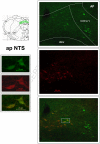Regional differences in estradiol effects on numbers of HSD2-containing neurons in the nucleus of the solitary tract of rats
- PMID: 20728435
- PMCID: PMC2949458
- DOI: 10.1016/j.brainres.2010.08.037
Regional differences in estradiol effects on numbers of HSD2-containing neurons in the nucleus of the solitary tract of rats
Abstract
Estrogens affect body fluid balance, including sodium ingestion. Recent findings of a population of neurons in the hindbrain nucleus of the solitary tract (NTS) of rats that are activated during sodium need suggest a possible central substrate for this effect of estrogens. We used immunohistochemistry to label neurons in the NTS that express 11-β-hydroxysteroid dehydrogenase type 2 (HSD2), an enzyme that promotes aldosterone binding, in male rats, and in ovariectomized (OVX) rats given estradiol benzoate (EB) or oil vehicle (OIL). During baseline conditions, the number of HSD2 immunoreactive neurons in the NTS immediately rostral to the area postrema was greater in EB-treated OVX rats compared to those in OIL-treated OVX and male rats. A small number of HSD2 immunoreactive neurons was also labeled for dopamine-β-hydroxylase (DBH), an enzyme involved in norepinephrine biosynthesis. Double-labeled neurons in the NTS were located primarily in the more lateral portion of the HSD2 population, at the level of the area postrema in all three groups, with no sex or estrogen-mediated differences in the number of double-labeled neurons. These results suggest that two subpopulations of HSD2 neurons are present in the NTS. One subpopulation, which does not colocalize with DBH and is increased during conditions of elevated estradiol, may contribute to the effects of estrogens on sodium ingestion. The role of the other, smaller subpopulation, which colocalizes with DBH and is not affected by estradiol, remains to be determined, but one possibility is that these latter neurons are part of a larger network of catecholaminergic input to neuroendocrine neurons in the hypothalamus.
Copyright © 2010 Elsevier B.V. All rights reserved.
Figures









Similar articles
-
Local inputs to aldosterone-sensitive neurons of the nucleus tractus solitarius.Neuroscience. 2006 Sep 15;141(4):1995-2005. doi: 10.1016/j.neuroscience.2006.05.059. Epub 2006 Jul 10. Neuroscience. 2006. PMID: 16828976
-
Aldosterone-sensitive neurons in the rat central nervous system.J Comp Neurol. 2006 Jan 20;494(3):515-27. doi: 10.1002/cne.20808. J Comp Neurol. 2006. PMID: 16320254
-
Phox2b expression in the aldosterone-sensitive HSD2 neurons of the NTS.Brain Res. 2008 Aug 21;1226:82-8. doi: 10.1016/j.brainres.2008.05.072. Epub 2008 Jun 7. Brain Res. 2008. PMID: 18620340 Free PMC article.
-
Aldosterone-sensitive neurons in the nucleus of the solitary: efferent projections.J Comp Neurol. 2006 Sep 20;498(3):223-50. J Comp Neurol. 2006. PMID: 16933386
-
Control of sodium appetite by hindbrain aldosterone-sensitive neurons.Mol Cell Endocrinol. 2024 Oct 1;592:112323. doi: 10.1016/j.mce.2024.112323. Epub 2024 Jun 26. Mol Cell Endocrinol. 2024. PMID: 38936597 Review.
Cited by
-
Neuroanatomical association of hypothalamic HSD2-containing neurons with ERα, catecholamines, or oxytocin: implications for feeding?Front Syst Neurosci. 2015 Jun 15;9:91. doi: 10.3389/fnsys.2015.00091. eCollection 2015. Front Syst Neurosci. 2015. PMID: 26124709 Free PMC article.
-
Time course of behavioral, physiological, and morphological changes after estradiol treatment of ovariectomized rats.Physiol Behav. 2011 Jun 1;103(3-4):261-7. doi: 10.1016/j.physbeh.2011.02.017. Epub 2011 Feb 12. Physiol Behav. 2011. PMID: 21324332 Free PMC article.
-
Estradiol selectively reduces central neural activation induced by hypertonic NaCl infusion in ovariectomized rats.Physiol Behav. 2012 Sep 10;107(2):192-200. doi: 10.1016/j.physbeh.2012.06.015. Epub 2012 Jul 2. Physiol Behav. 2012. PMID: 22763321 Free PMC article.
-
Synaptic mechanisms underlying the elevated sympathetic outflow in fructose-induced hypertension.Front Physiol. 2024 Mar 4;15:1365594. doi: 10.3389/fphys.2024.1365594. eCollection 2024. Front Physiol. 2024. PMID: 38505704 Free PMC article.
References
-
- Blackburn RE, Samson WK, Fulton RJ, Stricker EM, Verbalis JG. Central oxytocin and ANP receptors mediate osmotic inhibition of salt appetite in rats. Am. J. Physiol. 1995;269:R245–251. - PubMed
-
- Bossmar T, Forsling M, Akerlund M. Circulating oxytocin and vasopressin is influenced by ovarian steroid replacement in women. Acta Obstet. Gynecol. Scand. 1995;74:544–548. - PubMed
-
- Buller KM, Khanna S, Sibbald JR, Day TA. Central noradrenergic neurons signal via ATP to elicit vasopressin responses to haemorrhage. Neuroscience. 1996;73:637–642. - PubMed
-
- Chow SY, Sakai RR, Witcher JA, Adler NT, Epstein AN. Sex and sodium intake in the rat. Behav. Neurosci. 1992;106:172–180. - PubMed
Publication types
MeSH terms
Substances
Grants and funding
LinkOut - more resources
Full Text Sources
Miscellaneous

